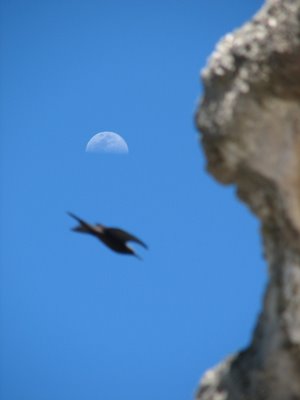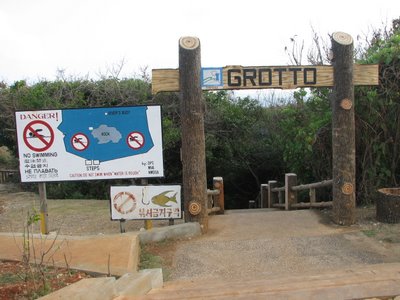The following map, from the CNMI Division of Fish and Wildlife website, illustrates the location of the MPAs on Saipan:
 While MPAs protect submerged lands, Wildlife Conservation Areas (WCA) protect areas that are on land. Comparing the following map to the previous map, you can see that the WCAs and the MPAs were designed in conjunction with one another to protect both the coral reefs and the watersheds that are economically and culturally important to Saipan:
While MPAs protect submerged lands, Wildlife Conservation Areas (WCA) protect areas that are on land. Comparing the following map to the previous map, you can see that the WCAs and the MPAs were designed in conjunction with one another to protect both the coral reefs and the watersheds that are economically and culturally important to Saipan: There are five MPAs in Saipan. I am going to highlight each of the MPAs on this blog. This is the second:
There are five MPAs in Saipan. I am going to highlight each of the MPAs on this blog. This is the second:Bird Island Sanctuary
 This is the view of Bird Island from the Bird Island Lookout.
This is the view of Bird Island from the Bird Island Lookout.The Bird Island Sanctuary was created in 2000 with the enactment of Public Law #12-46 (the same law that created the Forbidden Island Sanctuary). It stretches from right outside the grotto to just below the Bird Island Lookout (see map above, but it is pretty much everything you see in the above photo).
The two areas most popular with tourists are the Grotto and the Bird Island Lookout. It is also possible to hike down to the island, but very few people attempt to do so.
If you want to hike down to Bird Island Beach, here are the rules for visiting:
 The head of the trail down to Bird Island Beach is at the end of a grassy road about half way between the Grotto and the Lookout. It is easy to miss, because it is so small, but it is the only road between the Grotto and the Lookout, so just keep looking.
The head of the trail down to Bird Island Beach is at the end of a grassy road about half way between the Grotto and the Lookout. It is easy to miss, because it is so small, but it is the only road between the Grotto and the Lookout, so just keep looking.The beginning of the trail is marked with a small green sign that reads "Conservation Area." The hike down takes about 15 minutes. It is not nearly as steep as the trail down to Forbidden Island, but it is a little difficult at times. The trail can be very rocky and very muddy, especially if it has been raining.
Right before you step out onto the beach you have to walk through what looks like a dry stream bed. This is a great place to find hermit crabs and juvenile coconut crabs.
 Once you walk out onto the beach, Bird Island will be to your right and you will see the beach stretching in both directions. If you head over to your right there are two caves that can serve as shelter, but you can plop down anywhere on the sand.
Once you walk out onto the beach, Bird Island will be to your right and you will see the beach stretching in both directions. If you head over to your right there are two caves that can serve as shelter, but you can plop down anywhere on the sand. The Japanese used to call Bird Island "Moon Viewing Island." I tried to take a photo that incorporated the moon, the birds, and the island. The photo pictured above is what I came up with. Most of the birds flying around the island are black noddies. You can tell them apart from the brown noddies because they are smaller and have a white spot on their heads. They are all over the island. I can see why they named the place Bird Island.
The Japanese used to call Bird Island "Moon Viewing Island." I tried to take a photo that incorporated the moon, the birds, and the island. The photo pictured above is what I came up with. Most of the birds flying around the island are black noddies. You can tell them apart from the brown noddies because they are smaller and have a white spot on their heads. They are all over the island. I can see why they named the place Bird Island. I took a few pictures of some other birds, too. Here are just a few:
I took a few pictures of some other birds, too. Here are just a few:It is very easy to walk onto the island. The water between the beach and the island gets no deeper than 4 feet, even during high tide. You might get a little wet, but it is worth it because of all the interesting things on the island. I still don't have an underwater camera, so you will have to make do with above water shots for a few more weeks. Here you go:


 After you visit the tide pools, the next best activity is to go snorkeling. The water inside the reef flat is deep enough and there are plenty of fish to make for a very pleasing swim, but for those with a death wish, the option of going outside the reef is available. If you can't tell from my subtlety, I don't recommend swimming outside the reef. The waves are really strong and the currents are even stronger. The water also drops to about 100 feet just a few meters off the shore.
After you visit the tide pools, the next best activity is to go snorkeling. The water inside the reef flat is deep enough and there are plenty of fish to make for a very pleasing swim, but for those with a death wish, the option of going outside the reef is available. If you can't tell from my subtlety, I don't recommend swimming outside the reef. The waves are really strong and the currents are even stronger. The water also drops to about 100 feet just a few meters off the shore.Bird Island is also a great place to picnic. There are no facilities, but who needs a picnic table when you have a sandy white beach?
Then, if you're not too tired after your trip down to Bird Island, you might want to head over to the Grotto for a quick dip.
The Grotto is a sunken pool whose underwater passages lead to the ocean. Sunlight shining in through the caverns gives the water an unearthly blue hue. Pictures don't do it justice; you have to see it to believe it...but you have to walk down an extremely long stair case to see it (which you eventually have to walk back up).
The Grotto has been rated as one of the World's best diving spots, but you don't have to be a diver to go there. Many people just go there for a quick swim.
WARNING:
THE GROTTO CAN BE A DANGEROUS PLACE TO VISIT. PEOPLE HAVE DIED THERE. USE EXTREME CAUTION WHEN YOU GO THERE, AND TRY TO BRING SOMEONE WHO HAS BEEN DOWN THERE BEFORE AND KNOWS WHAT THEY ARE DOING, ESPECIALLY IF YOU ARE GOING TO ATTEMPT A DIVE.
Again I have to apologize for not having an underwater camera. Here are some shots from above the waterline:






 Can you see the little fish in the second to last photo? It is kind of towards the top in the center, sitting on the rock.
Can you see the little fish in the second to last photo? It is kind of towards the top in the center, sitting on the rock.I'll take plenty of pictures of underwater sea life once the RC&D camera arrives. I'll post a lot of them at our main website at www.hafa-adai.org, but I'll add the best ones to this blog.





No comments:
Post a Comment